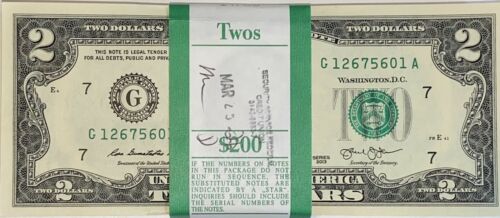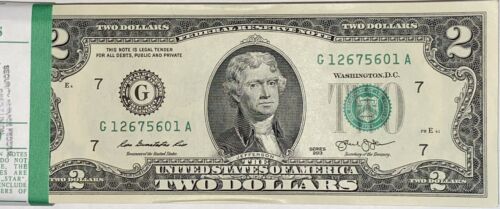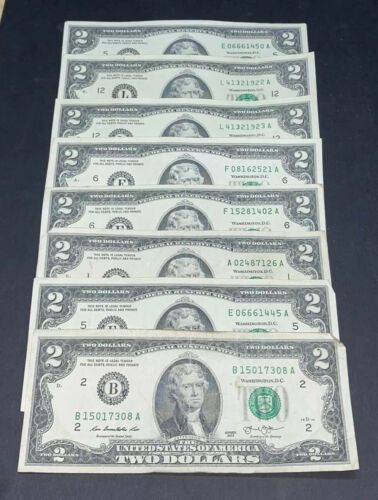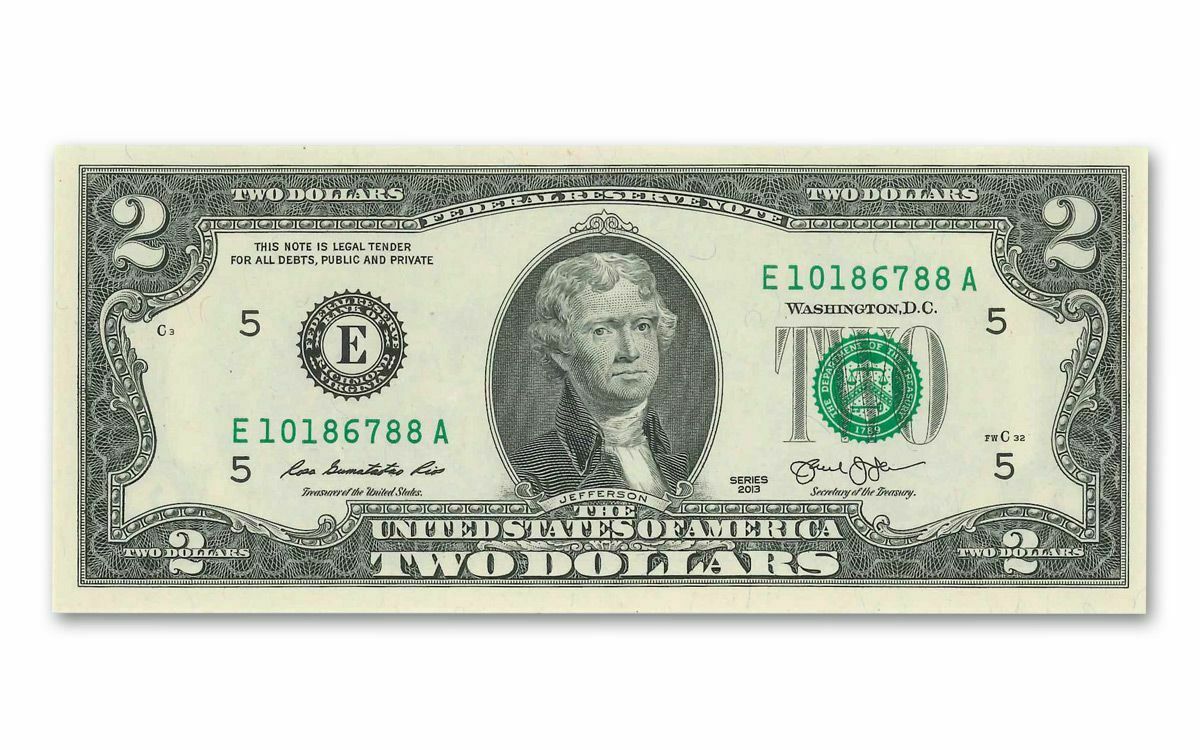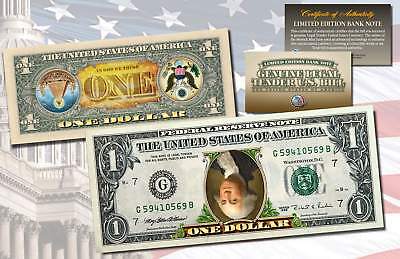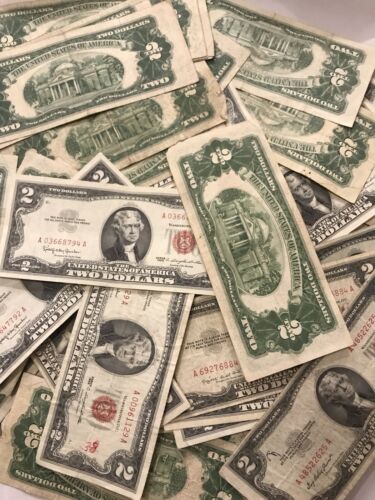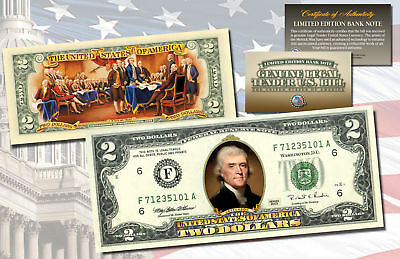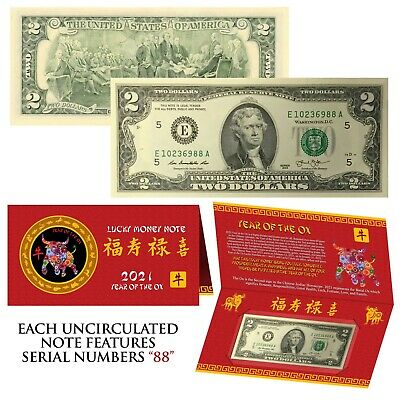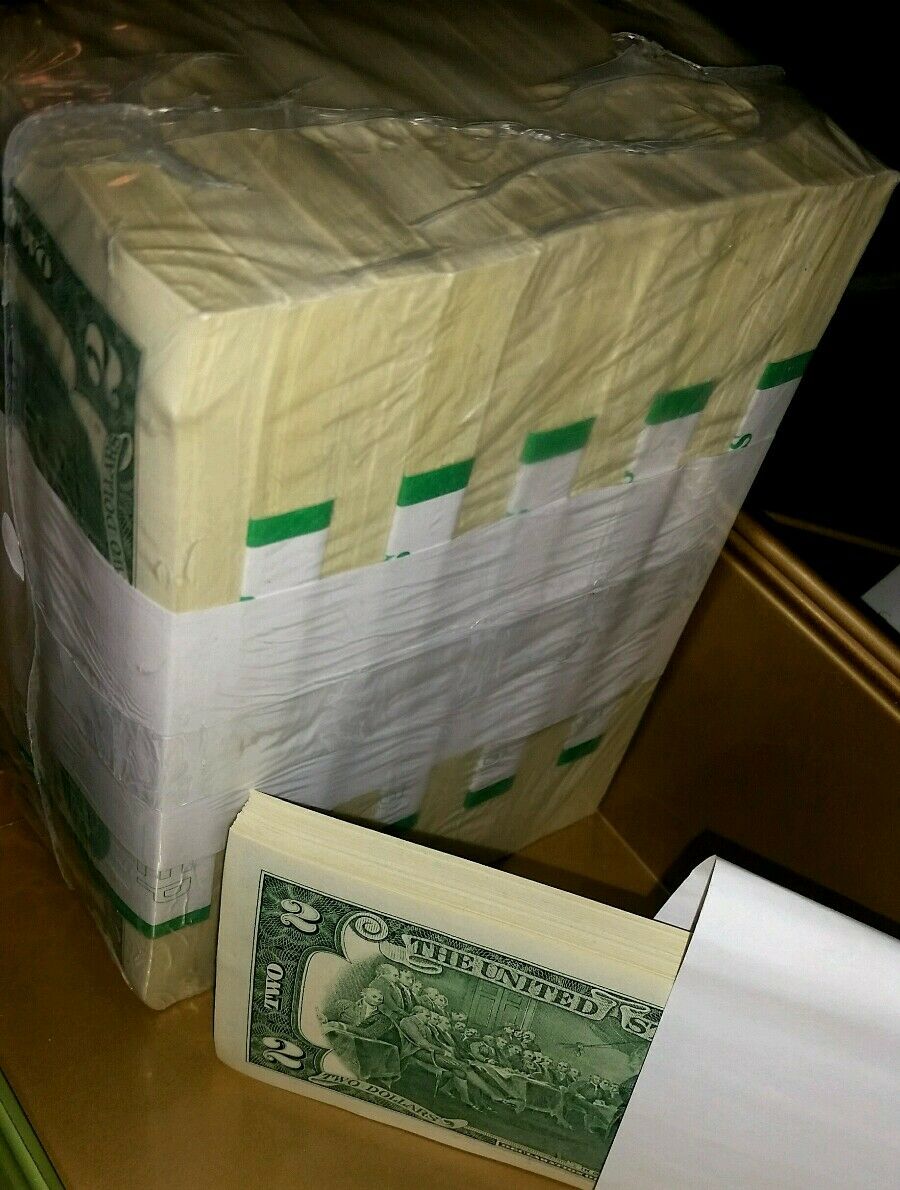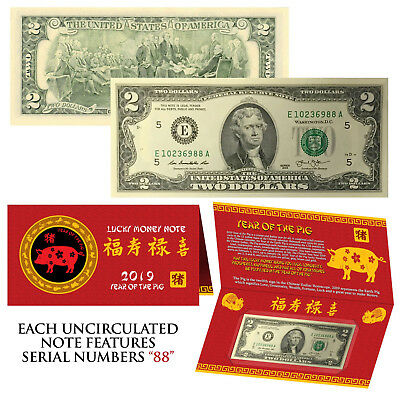-40%
ONE STACK OF 100 2013 TWO DOLLAR NOTES (G) CHICAGO DST CRISP GEM UNCIRCULATED
$ 147.83
- Description
- Size Guide
Description
BEAUTIFUL STRAP OF 100 SEQUENTIAL 2013 SERIES TWO DOLLAR FEDERAL RESERVE NOTES FROM THE RARE (G) DISTRICT OF CHICAGO, IL.FROM A NEW BEP BRICK GEM UNCIRCULATED NOTES.
ONE STRAP OF .00 BILLS 100 TWO DOLLAR BILLS PER STRAP.
PLEASE NOTE
Crisp, Mint Gem Uncirculated Condition, Never Circulated Bills!
⭐️
Please check out my other listings for more great items at huge discounts off of retail prices. Alamocityproductstx
Thank you for looking and have a wonderful day!
⭐️
Description:
Selling ONE STACK of sequential .00 bills
THESE BILLS HAVE NEVER BEEN IN CIRCULATION OR RUN THROUGH A COUNTER
All currency is legally purchased with trace-ability.
100% Legal US Currency from the Federal Reserve Bank
____________________________________________________________
WE DO OFFER COMBINED SHIPPING DISCOUNTS
____________________________________________________________
CURRENCY GRADING
GEM UNCIRCULATED – (65-70)
Usual Characteristics: no flaws or folds, excellent to perfect centering, strong embossing and thick paper
Gem notes are the royalty of currency collecting. They are not often encountered in grades 67 and up, and such notes command very strong prices. Gem notes should be clean with no distractions or folds. The centering should be within 75% of perfect. The colors and paper quality should be flawless. Unlike coins, a lot of currency is not even printed with the chance of becoming a gem.
CHOICE UNCIRCULATED – (64-65)
Usual Characteristics: no folds, less than perfect centering, counting mark or smudge, corner tip fold
Choice uncirculated notes will have no folds that run into the design. They may possess a small corner tip fold. For an otherwise perfect note to get a 63 or 64 it will have centering problems, meaning the margins are lopsided. A choice uncirculated note could also suffer from counting marks, smudges, or rough handling, all of which are explained below.
CRISP UNCIRCULATED (CU) - (59-63)
Usual Characteristics: no folds, less than perfect centering, light counting mark or smudge, corner fold or very light fold
A note that has not been released into circulation and is in the same condition as it was first produced. The paper must be firm and crisp, without any creases, folds or tears, and the corners must be sharp and square.
ABOUT UNCIRCULATED (AU) - (50-58)
Usual Characteristics: at most two light folds, corner folds, rough handling, minor noticeable flaw
A note that at first glance might appear as Uncirculated, but closer examination discloses the slightest signs of handling, some minor corner folds, a light (not hard) crease, a slight finger smudge or some pinholes. Paper is still crisp and bright and has original sheen. About uncirculated notes run the gamut from two very light folds on the low end, to a flaw so minor that it may barely be noticeable on the high end. In reality AU notes will likely not have seen any real time in circulation. Most flaws will be from poor storage or handling over many years. An AU note should be all about eye appeal. One can generally enjoy a full bodied AU even margined note for less than half the cost of its gem counterpart.
EXTRA FINE (XF) - (40-45)
Usual Characteristics: 2 or 3 vertical folds, very lightly circulated, very visually pleasing, no discoloration
Paper is clean and bright with original sheen. Light handling is apparent, with several light folds or one strong crease visible. Tears and stains are not present. Extremely fine notes will likely have seen very little to no actual circulation. Your standard XF note will have 3 vertical folds, usually from poor storage, or several bends it may have picked up over time. Extremely fine notes should have good color and paper quality.
VERY FINE (VF) - (30-35)
Usual Characteristics: a few of folds, lightly circulated, maybe a smudge or rough handling, fairly crisp paper
Still an attractive note, but with more pronounced wear from handling, though some crispness remains. May have several vertical and horizontal folds as well as slight dirt or smudging visible. No tears on the edges, though the corners are not as sharp as Uncirculated. High grade very fine notes can be a great way to get an attractive original note for a fraction of the price of their uncirculated cousins. Buyer beware though, very fine notes are often subject to washing to increase their eye appeal. If you hold a raw very fine note if should feel strong and thick. It will have noticeable folds but it should be very presentable otherwise.
VERY FINE (VF) - (20-25)
Usual Characteristics: multiple folds, above average wear, used but fully intact
When looking at a note you think may be a low grade very fine, be sure to look for repairs and tears that may not be obvious on just a casual look. A low grade very fine note will tend to pancake when held in hand, the original crispiness just will not be there. When seeking rarity you may have to settle for a low grade very fine note. The average note pulled from circulation would likely grade a 20 or 25.
FINE (F) - (12-15)
Usual Characteristics: little crispiness, somewhat leathered look, numerous folds, faded colors
Considerable circulation is apparent, with creases, folds and wrinkles visible, and most, if not all, of the crispness is gone. Edges show evidence of circulation, and there may be slight tears. Some fading of color noticeable, with some staining possible. A note in fine grade generally has the appearance as if has been balled up and worn in a gym sock for a week and then straightened back out. A fine note will have no crispiness and a leathered look. Expect beat up corners and faded colors in this grade. One positive thing about a fine note is that you generally know what you are getting into, even based on a scan.
VERY GOOD (VG) - (8-10)
Usual Characteristics: minor tears, no body, very well worn, not much eye appeal
An obviously well-circulated bank note with much creasing, folding and wrinkling noticeable. Note may be dirty, and corners may show much wear and rounding, and some tears may be present, though no pieces of the note should be missing. A very good note will have more wear and less eye appeal than a fine note, but it will lack a significant flaw that good notes will have. Generally speaking, a very good note will be dirty but not totally trashed. For common very good notes there will not be a big price difference from the 8-15 range, so it would be advised to buy the one that has the most eye appeal over the one that may have the higher technical grade.
GOOD (G) - (4)
Usual Characteristics: serious problems – very dirty – missing corners – splitting margins, tears
A heavily circulated note with characteristics similar to Very Good except with more pronounced soiling and considerable wear and tear. Corners of the note may also be missing. Typically, good notes are collected only as a second thought, usually by people who just fancy having “some old paper money.” Good notes were usually picked out of circulation after many years. They are readily available on eBay and you won’t need a second mortgage to get a full type set together. Good notes are great if you are trying to get a child in the hobby or if you want to collect as cheap as possible.
_-_-_-_-_-_-_-_-_-_-_-_-_-_-_-_-_-_-_-_-_-_-_-_
EXAMPLES & TERMS
Handling – Handling is a generic term that can refer to counting marks, pinches or smudges
Counting Marks – very light bends going into the note that aren’t folds
Pinches – are similar to counting marks but they occur internally on the note
Smudges – are the result of skin contact to ink surfaces
Originality – means the paper has not been pressed or washed and embossing and paper wave should be present
Embossing – is when the note’s printing can be felt on the other side of the note, this should be especially present around the serial numbers and treasury seal
Paper Wave – refers to the light ripples that should go across the top and bottom of a note, this is a result of wet paper drying after the printing process
_-_-_-_-_-_-_-_-_-_-_-_-_-_-_-_-_-_-_-_-_-_-_-_
Items always ship well protected, insured, and the same or next day after receiving clear payment
REAL US LEGAL TENDER CURRENCY
INTERNATIONAL BUYERS - Please Note:
Import duties, taxes and charges are not included in the item price or shipping charges. These charges are the buyer's responsibility and are normally collected by the delivery (shipping) company, do not confuse them for additional shipping charges.
Please check with your country's customs office to determine what these additional costs will be prior to bidding/buying. International buyer is also responsible for any return shipping cost.
ONE STACK OF 2017A TWO DOLLAR NOTES CRISP GEM UNCIRCULATED BEP PACK FROM BRICK. Shipped with USPS.
